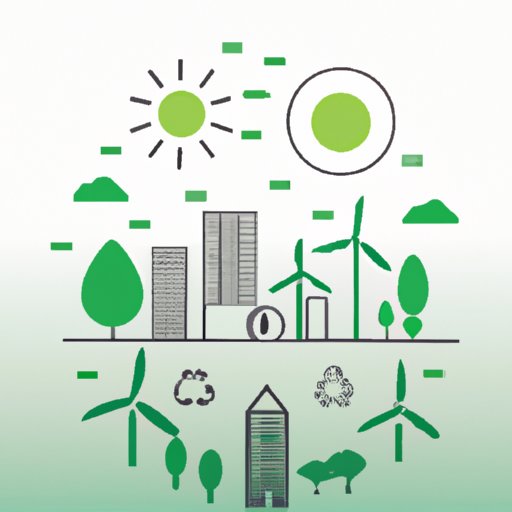Introduction
As global warming and climate change become increasingly serious issues, it’s more important than ever to be aware of our environmental impact and take steps to reduce it. Living an eco-friendly lifestyle doesn’t have to mean major changes or sacrifices — there are plenty of small but impactful ways we can all do our part to help the environment. This comprehensive guide provides practical tips on how to be more environmentally friendly in your everyday life.
Overview of Environmental Problems
The United Nations has identified a number of environmental problems facing our planet, including air pollution, water scarcity and contamination, natural resource depletion, loss of biodiversity, and climate change. All of these issues are caused by human activities, such as burning fossil fuels, unsustainable agriculture practices, deforestation, and overconsumption. The effects of climate change are already being felt around the world, with extreme weather events becoming more frequent and intense, sea levels rising, and habitats shifting.
It’s clear that we need to do more to protect our planet and its inhabitants. We all have a role to play in creating a more sustainable future, and there are many simple ways to make a difference.
How to Be More Environmentally Friendly
Here are some key steps you can take to reduce your environmental footprint:
Reduce Energy Consumption
One of the most important things you can do is to reduce your energy consumption. According to the U.S. Energy Information Administration, about two-thirds of the energy used in the United States comes from fossil fuels like coal, natural gas, and petroleum, which are responsible for emitting large amounts of carbon dioxide into the atmosphere. By cutting down on your energy use, you can help reduce emissions and fight climate change.
Invest in Energy-Efficient Appliances
When shopping for appliances, look for the “Energy Star” label, which indicates that the product meets certain energy efficiency standards. Using energy-efficient appliances can save you money on your energy bills and reduce your environmental impact.
Turn off Lights When Not in Use
Another easy way to save energy is to turn off lights when not in use. According to a study conducted by the American Council for an Energy-Efficient Economy, replacing traditional incandescent bulbs with LED bulbs can save up to 75% of lighting costs.

Reusable Items Over Disposable Ones
Whenever possible, opt for reusable items rather than disposable ones. This helps reduce waste and conserve resources.
Shopping Bags
When shopping, bring your own reusable bags instead of using plastic or paper bags. According to the Environmental Protection Agency (EPA), Americans throw away 100 billion plastic bags per year, and only 1% of those bags are recycled.
Water Bottles
Instead of buying bottled water, invest in a reusable water bottle. Plastic bottles are made from petroleum and other chemicals, and they take hundreds of years to decompose. Plus, they create a lot of unnecessary waste.
Food Containers
Bring your own containers when ordering food to go. This will help reduce the amount of Styrofoam and plastic containers that end up in landfills.
Recycling and Composting
Recycling and composting are easy ways to reduce waste and conserve resources. Recycling involves separating materials like steel, aluminum, paper, and plastic so they can be processed and reused. Composting involves breaking down organic materials, such as food scraps and yard waste, into a nutrient-rich soil amendment.
Benefits of Reducing Waste
According to the EPA, recycling and composting help conserve resources, save energy, reduce greenhouse gas emissions, and create jobs.
Proper Sorting and Collection of Materials
To ensure that materials are properly recycled, it’s important to sort them into separate categories and make sure they’re collected properly. Check with your local waste management company for information on what materials can be recycled and how to dispose of them.

Sustainable and Locally Grown Foods
Buying sustainable and locally grown foods is another great way to reduce your environmental impact. Eating local helps support local farmers, reduces food miles (the distance food travels from farm to plate), and helps preserve agricultural land.
Advantages of Eating Local
According to a study conducted by the University of California-Davis, eating local foods can help reduce greenhouse gas emissions, conserve water, protect biodiversity, and support local economies.
Identifying Sustainable Products
Look for labels like “organic” and “fair trade” to identify sustainable products. Ask your local grocer or farmer’s market vendor if they carry any locally grown or organic products.
Supporting Eco-Friendly Companies
By supporting businesses that practice sustainability, you can help promote a greener economy. Look for companies that use renewable energy sources and sustainable manufacturing practices.
Renewable Energy Sources
Look for businesses that use renewable energy sources, such as solar, wind, and geothermal power. These sources produce less pollution than traditional energy sources, such as coal and natural gas.
Sustainable Manufacturing Practices
Look for companies that use sustainable manufacturing practices, such as reducing waste, conserving water, and minimizing their carbon footprint. Companies that have committed to sustainability often share this information on their websites or in their marketing materials.
Conclusion
Living an eco-friendly lifestyle is essential for the preservation of our planet. Taking small steps, such as reducing energy consumption, using reusable items, recycling and composting, eating local, and supporting sustainable businesses can all make a big difference. It’s time to start taking responsibility for our actions and work together to create a more sustainable future.
(Note: Is this article not meeting your expectations? Do you have knowledge or insights to share? Unlock new opportunities and expand your reach by joining our authors team. Click Registration to join us and share your expertise with our readers.)
